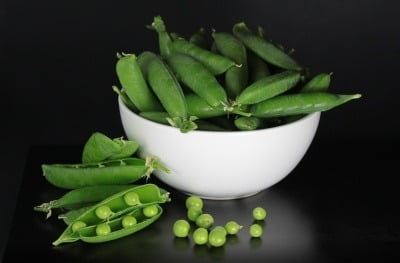
Pea protein is the rising star for product developers seeking alternatives to dairy and cereal proteins. This article examines some of that potential.
Peas (Pisum sativum) have been known as a food source for well over 8,000 years and were first cultivated in the Near East. They’ve been an important component of the diet particularly for vegetarians as a protein source too, forming the basis of many important recipes. Growing them is straightforward for the keen gardener and an important nitrogen-fixer in soils impoverished by over cultivation. It has environmental credentials too if sustainability is required. Pea is not an allergen and is a very good source of amino-acids as well as having a balanced protein profile ! The crude protein content is about 225g/kg dry weight and makes an excellent concentrate and isolate for use in functional foods. One possibility that product developers are now on the lookout for is as a replacement of dairy and soy protein, performing well-established functions in beverages especially for sports and general muscle building, in bars, gels, energy balls, and other recipes demanding functionality as well as nutrition. Pea proteins have also been tested in powdered drinks, fortified waters, snacks such as popcorn and cereals especially where gluten contents need to be reduced.
The literature on pea protein is well covered and one should look no further than Sandberg’s review on the performance of pea protein in various food products (Sandberg, 2000) and the applications described therein. It is a highly genetically variable plant and contains two major storage proteins which vary widely in their ratios:- legumin and vicilin. It should be possible with careful hybridisation to generate protein mixes with varying levels of amino-acids.
Preparation Of Pea Proteins
The proteins are separated from starch and fibre in a multi-step process using acidic pHs to influence solubilisation. The separation process relies on manipulating the relative isoelectric points of the proteins. Pisum proteins, especially the globulin fractions also have excellent emulsifying properties (Dagorn-Scaviner et al., 1987) comparable with soy protein. Compared to wheat gluten, the level of fat absorption is low. The phytate level is high and requires treatment with phytase enzyme to reduce it. Pea protein also produces good, firm gels (Nunes et al., 2006). Hydrolysates of pea protein are best modified using proteases such as papain and chymotrypsin (Humiski and Aluko, 2007). Antifungal peptides have also been reported from two ribosome inactivating proteins known as the pisavins (Lam et al., 1998).
Commercial Sources
Commercial sources for the product developer include Nutralys™ from Roquette. These proteins are extracted and purified from yellow peas and the isolate is specified at 85-90%w/w with 98% digestability. Try also Peazazz™ from Burcon NutraScience Corp., Vancouver, British Columbia which has been showcased. Burcon’s pea isolate worked well in their application examples Orange Mango Rhythm (30% juice beverage) and Vanilla Jazz (fortified diary alternative) on show at the 2013 IFT Expo. These were products without artificial ingredients and presenting at 5 g per 250ml serving. Early work with this ingredient often gave beverages a slightly green, almost bitter taste but in recent years the extracted pea proteins are clean tasting and much more soluble especially in acidic fruit based beverages which is a bonus. Could it also have satiation (stomach-filling) properties too ? Probably although it looks as if more research is needed here.
Nutrition Of Pea Protein Isolate
This is currently just a snap-shot in pea protein functionality and I’m currently investigating applications for pea proteins generally – any thoughts welcome. The nutrition data from a number of sources is:-
| Nutrition | per 30g Serving | per 100g |
| Energy kJ/Kcal | 496/119 | 1653/395 |
| Fat of which saturates |
1.8g 0.3g |
6g 1g |
| Carbohydrates of which sugars |
0.9g 0.03g |
3g 0.1g |
| Fibre | 0.33g | 1g |
| Protein | 24g | 80g |
| Salt | 0.57g | 1.9g |
Pea protein isolate is ideal for vegetarians and vegans. It is also ideal for halal, kosher, gluten-free, dairy-free, lactose free and soya free products. Just make a note that pea itself is an allergen and must be notified in bold on any label.
Uses For Sports People
Sports people using pea protein isolate would recommend that about 30g of this ingredient is mixed into 330ml of cold water and consumed whenever additional dietary protein is needed. A common situation is for sports people adopting a vegan/vegetarian diet. To be frank the taste is not great !
Having done exercise, it is probably easier to add a rapid acting carbohydrate such as dextrose, maltodextrin or waxy starch maize for a more balanced food. Additional blends also include omega oils, maca powder and other superfood greens to achieve a more balanced !
Products
Please note this page contains links to our affiliate marketing partner. Please read our affiliate disclosure.
References
Dagorn-Scaviner, C., Gueguen, J., Lefebvre, J. (1987) Emulsifying Properties of pea Glubulins as Related to Their Adsorption Behaviours. J. Food Sci. 52 (2) pp. 335-341
Humiski, L. M., & Aluko R. E. (2007). Physicochemical and bitterness properties of 388 enzymatic pea protein hydrolysates. J. Food Sci., 72, S605–S611
Lam, S.S.L., Wang, H., Ng, T.B. (1998) Purification and Characterization of Novel Ribosome Inactivating Proteins, Alpha- and Beta-Pisavins, from Seeds of the Garden Pea Pisum Sativum. Biochem. Biophys. Res. Comm. 253(1) pp. 135-142
Sandberg, A.-S. (2000) Developing Functional Ingredients: A Case Study. In: Functional Foods: Concept to Product. Edt. G.R. Gibson and C.M. Williams. Woodhead Publ. Ltd. Cambridge. England.
Nunes, M. C., Raymundo, A., & Sousa, I. (2006). Gelled vegetable desserts containing pea protein, κ-carrageenan and starch. European Food Research and Technology, 222, pp. 622-628.
Leave a Reply